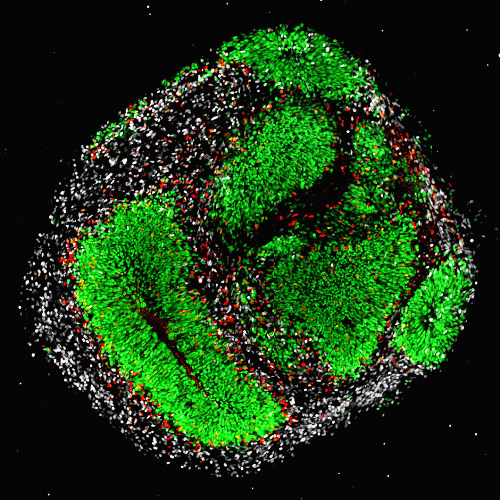|

CLICK ON weeks 0 - 40 and follow along every 2 weeks of fetal development
|
||||||||||||||||||||||||||||
|
Developmental Biology - Brain Development Lipid Metabolism Controls Brain Development Researchers altered gene information in both mice and human organoids, so that the FASN enzyme exhibits the exact mutation found in people with cognitive deficits. Diminished stem cell activity reduces cognitive performance Stem cells constantly generate new nerve cells in both mice and humans. Hyperactivity of the mutated FASN enzyme allows fats to accumulate inside the stem cell, putting the cell under stress and reducing its ability to divide. Similar to cognitive deficits found in affected humans, mice display learning and memory deficits due to the FASN mutation. "Our results provide evidence of the functional correlation between lipid metabolism, stem cell activity and cognitive performance." The now identified mechanism reveals how lipid metabolism regulates neuronal stem cell activity — thus influencing brain development. "These new discoveries were only made possible by linking research on animal models to human organoids," surmises Jessberger. This methodology may provide a "blueprint" for research into brain stem cells and their role in cognitive processing. "In addition, we hope it will be possible to control stem cell activity therapeutically for use in brain repair - for example treatment of cognitive disorders, or in association with diseases that involve the death of nerve cells, such as Parkinson's or Alzheimer's ." Summary The phenotypic and functional dichotomy between IRF8+ type 1 and IRF4+ type 2 conventional dendritic cells (cDC1s and cDC2s, respectively) is well accepted; it is unknown how robust this dichotomy is under inflammatory conditions, when additionally monocyte-derived cells (MCs) become competent antigen-presenting cells (APCs). Using single-cell technologies in models of respiratory viral infection, we found that lung cDC2s acquired expression of the Fc receptor CD64 shared with MCs and of IRF8 shared with cDC1s. These inflammatory cDC2s (inf-cDC2s) were superior in inducing CD4+ T helper (Th) cell polarization while simultaneously presenting antigen to CD8+ T cells. When carefully separated from inf-cDC2s, MCs lacked APC function. InfcDC2s matured in response to cell-intrinsic Toll-like receptor and type 1 interferon receptor signaling, upregulated an IRF8-dependent maturation module, and acquired antigens via convalescent serum and Fc receptors. Because hybrid inf-cDC2s are easily confused with monocyte derived cells, their existence could explain why APC functions have been attributed to MCs. Authors Cedric Bosteels, Katrijn Neyt, Manon Vanheerswynghels, Mary J. van Helden, Dorine Sichien, Nincy Debeuf, Sofie De Prijck, Victor Bosteels, Niels Vandamme, Liesbet Martens, Yvan Saeys, Els Louagie, Manon Lesage, David L. Williams, Shiau-Choot Tang, Johannes U. Mayer, Franca Ronchese, Charlotte L. Scott, Hamida Hammad, Martin Guilliams, Bart N. Lambrecht. Acknowledgements This study was funded by the European Research Council, University Ghent, Research Foundation Flanders (FWO), and the Health Research Council New Zealand. Return to top of page. | May 13  With cerebral organoids produced by human embryonic stem cells, the early development of the human brain was investigated. The organ-like cell cultures consist of neural stem cells (green), progenitor cells (red) and nerve cells (white). CREDIT Daniel Gonzalez-Bohorquez, UZH
|
||||||||||||||||||||||||||||

